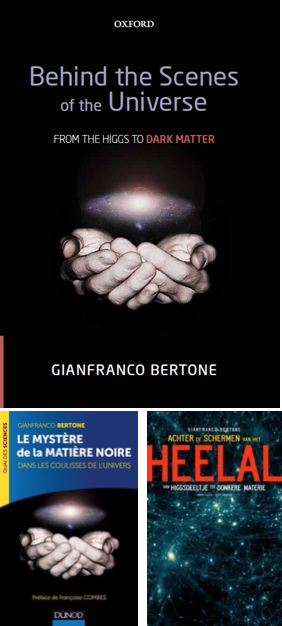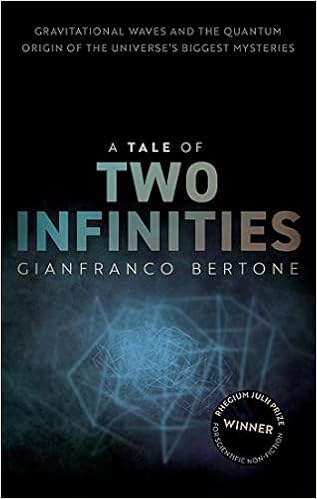A Tale of Two Infinities (2021)
This cutting-edge book investigates the extraordinary potential of multimessenger astronomy to revolutionise our understanding of the universe
The spectacular advances of modern astronomy have opened our horizon on an unexpected cosmos: a dark, mysterious universe, populated by enigmatic entities we know very little about, like black holes, or nothing at all, like dark matter and dark energy.
This book discusses the extraordinary potential of a new discipline dubbed ‘multimessenger astronomy’, combining the traditional approach based on the observation of light from celestial objects, with a new method based on other ‘messengers’ – such as gravitational waves, neutrinos, and cosmic rays – that carry information from otherwise inaccessible corners of the universe.
Interweaving the discussion of multimessenger astronomy with an exploration of the surprising connections between the study of the universe on the largest scales, and the physics of the infinitely small, this text provides an accessible and fascinating introduction to cutting-edge findings in recent cosmology which could soon revolutionize our understanding of the universe.
Reviews
The author lets his enthusiasm for the subject and its research enterprises shine through, which is an excellent feature — Dave Pike, The Observatory
Particularly timely, and of great appeal to a wide readership from the professional scientist to the intelligent layperson — Professor Sir James Hough, University of Glasgow
A timely, engrossing, witty yet scholarly work, this book is essential reading for anybody interested in the cutting edge of cosmology. Prof. Bertone is an expert guide with the rare gift of presenting complex ideas in an accessible, original and compelling way. An armchair journey to the limits of the known universe and beyond! — Professor Roberto Trotta, Imperial College London and International School for Advanced Studies (SISSA)
This is an excellent book that will convey to the lay public the excitement of recent discoveries that are bringing us novel and even revolutionary insights about the nature of the cosmos we inhabit — Professor Abhay Ashtekar, Director of the Institute for Gravitational Physics and Geometry at Pennsylvania State University
A clear and readable account of humanity’s fascination with the cosmos, from ancient times to the Nobel prizewinning observation of gravitational waves. Explains the triumphs and crises of current theories of the origin and structure of the universe in simple, accessible terms. Enjoyable and informative — Professor Ian Stewart FRS, author of Calculating the Cosmos
An intriguing blend of cosmic mysteries and observational probes, with a delightfully accessible approach — Joseph Silk, Homewood Professor of Physics and Astronomy, Johns Hopkins University
A lively introduction to the newly emerging field of multi-messenger astronomy, outlining the certainties and possibilities as well as the intriguing open questions – a must-read for young minds who want to venture into this new and exciting journey of cosmic exploration — Priyamvada Natarajan, astrophysicist and author of Mapping the Heavens: The Radical Scientific Ideas That Reveal the Cosmos
With equal parts flair and sophistication, Bertone takes us on an incredible tour of our universe’s greatest mysteries. The language is at times so evocative you might forget you’re actually learning something! — Dan Hooper, Head of the Theoretical Astrophysics Group, Fermi National Accelerator Laboratory; Professor of Astronomy and Astrophysics, University of Chicago
In this charming book, Gianfranco Bertone considers puts cutting-edge ideas — black holes, dark energy, inflationary cosmology — into their proper context as part of humanity’s ongoing quest to understand the universe. Wonderfully written, Tale of Two Infinities manages to illuminate cosmic vistas while never losing sight of the human perspective — Sean Carroll, author of Something Deeply Hidden: Quantum Worlds and the Emergence of Spacetime
The detection of gravitational waves in 2015 was just the beginning. The insatiably curious seeking context and some sense of the promise of these new starry messengers should look no further. Gianfranco Bertone is a sure guide, and A Tale of Two Infinities is an engaging tour — Jim Baggott, author of Quantum Reality
The recent developments in Cosmology have shown that the infinitely big (the Universe) and the infinitely small (fundamental forces and particles, structure of spacetime at the microscopic, subatomic level) have never been so close to each other. Physicists studying both infinities ask the same questions and look for the same answers. The reader will feel comfortably cradled between these two infinities. The text manages to present the latest, on-going revolution brought about by the recent direct detection of gravitational waves in a simple way yet respecting and reflecting the deep meaning of it. Enjoy! — Licia Verde, ICREA professor, Instituto de Ciencias del Cosmos (ICC), University of Barcelona
Behind the Scenes of the Universe – From the Higgs to Dark Matter (2013)

In this book, aimed at the general reader with an interest in science, the author illustrates in non-technical terms, borrowing concepts and ideas from other branches of art and literature, the far-reaching implications of this discovery. It has led to a worldwide race to identify the nature of this mysterious form of matter. We may be about to witness a pivotal paradigm shift in Physics, as we set out to test the existence of dark matter particles with a wide array of experiments, including the Large Hadron Collider at CERN, as well as with a new generation of Astroparticle experiments underground and in space.About the book: An extraordinary discovery has recently shaken the foundations of Cosmology and Particle Physics, sparking a scientific revolution that has profoundly modified our understanding of our Universe and that is still far from over. Pioneering astronomers in the 1920s and 1930s had already noticed suspicious anomalies in the motion of celestial bodies in distant galaxies and clusters of galaxies, but it wasn’t until the late 20th century that the scientific community was confronted with an astonishing conclusion: the Universe is filled with an unknown, elusive substance that is fundamentally different from anything we have ever seen with our telescopes or measured in our laboratories. It is called dark matter, and it constitutes one of the most pressing challenges of modern science.
Get it from the website of Oxford U. Press
The book is also available in French (Dunod), Dutch (Prometeus) and Italian (Carocci)
Reviews:
“We are living in the golden age of dark matter, where thousands of scientists around the globe are furiously competing to see who will discover the secret of dark matter first. World renowned physicist Gianfranco Bertone offers a unique perspective on this hunt, clearly explaining the evidence that dark matter exists and the various methods people are using to find it. In the world’s greatest ongoing reality show, Bertone is the perfect host. ” – Scott Dodelson, Fermi National Accelerator Laboratory and the Kavli Institute for Cosmological Physics
“An excellent overview of the quest to understand the mysterious nature of dark matter, the dominant constituent of matter in the Universe. Bertone, a leading researcher in this field, presents a comprehensive yet concise summary of the history and current status of this puzzle. The book provides a well-written, easily accessible introduction (without equations or technical jargon) to an extremely exciting frontier at the interface between cosmology and particle physics.” – Avi Loeb, Department of Astronomy, Harvard University
“Understanding the nature of the Universe is one of the most challenging tasks facing mankind, but in this book Gianfranco Bertone tackles the questions posed in a manner totally accessible to all with an interest in the area, from the layperson to the professional scientist. The reader is taken on an exciting journey through astronomy, particle astrophysics and cosmology. A book not to be missed! ” – James Hough, Institute for Gravitational Research, University of Glasgow
Particle Dark Matter – Observations, Models and Searches (2010)

Dark matter is among the most important open problems in modern physics. Aimed at graduate students and researchers, this book describes the theoretical and experimental aspects of the dark matter problem in particle physics, astrophysics and cosmology.
Featuring contributions from 48 leading theorists and experimentalists, it presents many aspects, from astrophysical observations to particle physics candidates, and from the prospects for detection at colliders to direct and indirect searches. The book introduces observational evidence for dark matter along with a detailed discussion of the state-of-the-art of numerical simulations and alternative explanations in terms of modified gravity. It then moves on to the candidates arising from theories beyond the Standard Model of particle physics, and to the prospects for detection at accelerators.
It concludes by looking at direct and indirect dark matter searches, and the prospects for detecting the particle nature of dark matter with astrophysical experiments.

Contributors:
G. Bertone, J. Silk, B. Moore, J. Diemand, J. Bullock, M. Kaplinghat, L. Strigari, Y. Mellier, D. Merritt, J. Bekenstein, G. Gelmini, P. Gondolo, J. Ellis, K. Olive, G. Servant, J. L. Feng, P. Sikivie, M. Shaposhnikov, T. Plehn, G. Polesello, M. Battaglia, M. E. Peskin, K. Kong, K. Matchev, F. Boudjema, J. Edsjö, D. G. Cerdeño, A. Green, R. Bernabei, P. Belli, N. Fornengo, G. Gerbier, J. Gascon, E. Aprile, L. Baudis, N. Spooner, S. Asztalos, L. Bergström, F. Halzen, D. Hooper, P. Salati, F. Donato, S. Profumo, P. Ullio, K. Jedamzik, M. Pospelov
